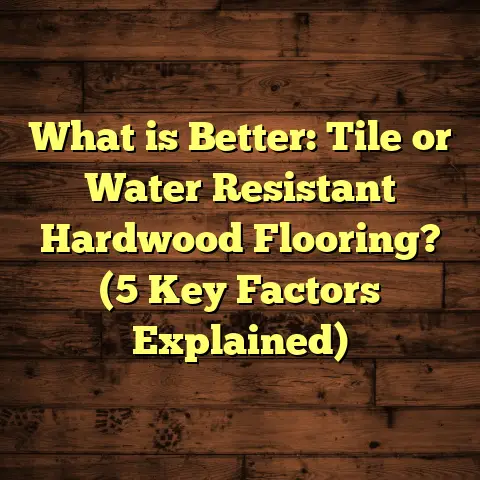What is Bamboo and Cork Flooring? (5 Benefits Revealed!)
I still remember the day I first stepped into a home that had bamboo flooring. It was a beautiful space filled with natural light, and the floor seemed to glow softly. It wasn’t like any hardwood floor I’d seen before—it felt alive, vibrant, and surprisingly durable. I was curious and asked the homeowner about it. That’s when I discovered bamboo flooring—a material that I hadn’t paid much attention to before but would soon become one of my favorite floorings to work with. The same goes for cork flooring, which I encountered a few years later in a cozy yoga studio. The soft, cushioned feel underfoot was unlike anything else. Both materials intrigued me, not just because they were beautiful but because they carried stories of sustainability, innovation, and comfort.
If you’re thinking about flooring options for your home or project, you might have heard these names but wondered what exactly they are. Let’s chat about bamboo and cork flooring—their origins, how they’re made, their benefits, and whether they might be right for your space.
What is Bamboo and Cork Flooring?
Bamboo Flooring: More Than Just Grass
Bamboo is technically a grass—not a tree—but it has qualities that rival hardwood trees when processed for flooring. This fast-growing plant is native to Asia but now cultivated worldwide. When harvested for flooring, bamboo stalks are cut, boiled to remove starches and sugars that attract pests, then dried and laminated into planks.
The manufacturing technique affects how the floor looks and performs:
- Vertical Cut Bamboo: Strips are aligned vertically, showing thin lines that create a textured surface.
- Horizontal Cut Bamboo: Strips are laid flat, showing wider grain patterns.
- Strand-Woven Bamboo: Bamboo fibers are shredded and compressed under high heat and pressure with resin binders. This results in a super-dense product that’s harder than many hardwoods.
In terms of appearance, bamboo flooring tends to have a clean, modern look with subtle grain patterns or a more rugged texture depending on the cut.
Cork Flooring: Nature’s Cushion
Cork comes from the bark of the cork oak tree (Quercus suber), mainly found in Mediterranean regions like Portugal and Spain. The harvesting process is fascinating—only the bark is stripped every 9-12 years without damaging the tree which continues to live for decades.
Once harvested, the bark is boiled to increase flexibility and sterilize it. Then it’s ground into granules and mixed with binders before being pressed into tiles or planks. This process preserves cork’s natural cellular structure—a honeycomb-like pattern full of air pockets.
Because of this structure, cork floors are soft, resilient, and provide excellent insulation against noise and temperature changes.
Comparing Bamboo & Cork Flooring
While both come from renewable plant sources, their characteristics are quite different:
| Feature | Bamboo Flooring | Cork Flooring |
|---|---|---|
| Source | Bamboo grass | Cork oak tree bark |
| Appearance | Smooth or textured wood look | Speckled, natural warmth |
| Hardness (Janka) | Up to 4,000 (strand-woven) | Soft (~1,000) |
| Moisture Resistance | Moderate (needs sealing) | Moderate (needs sealing) |
| Comfort | Firm underfoot | Soft and cushioned |
| Noise Absorption | Moderate | High |
| Sustainability | Fast-growing renewable resource | Renewable bark harvesting |
Why Choose Bamboo or Cork Flooring? 5 Benefits You Should Know
After years installing these floors across various projects—from family homes to commercial spaces—I’ve noticed five standout benefits that often surprise people.
1. Sustainability: Flooring That Respects Nature
If you care about being environmentally responsible (and who doesn’t?), bamboo and cork are fantastic choices.
Bamboo’s Fast Growth Rate
Unlike hardwood trees that take decades to mature, bamboo can grow up to three feet in 24 hours under ideal conditions! It reaches harvestable size in just 3-5 years. This rapid growth means harvesting bamboo causes less deforestation pressure.
I once worked on an eco-friendly home renovation where the client specifically wanted FSC-certified bamboo flooring. The Forest Stewardship Council ensures the bamboo was harvested sustainably with respect for local ecosystems.
Did you know? Bamboo absorbs more carbon dioxide and releases more oxygen than many tree species—up to 35% more oxygen per hectare compared to trees.
Cork’s Gentle Harvesting
Cork oak trees can live over 200 years. Their bark is stripped carefully every decade without harming the tree itself. This method allows cork forests to thrive while supporting biodiversity—many endangered species call cork forests home.
A fascinating case study comes from Portugal’s cork industry where cork harvest supports local economies while preserving natural habitats.
2. Durability: Tough Enough for Real Life
People often ask me if bamboo or cork can handle daily wear and tear—especially in busy homes with kids or pets.
Bamboo’s Strength
Strand-woven bamboo ranks extremely high on the Janka hardness scale—between 3,000 to 4,000—making it harder than traditional hardwoods like oak (1,290) or maple (1,450). This means it resists dents and scratches well.
One family I worked with has two dogs that love running around their strand-woven bamboo floor. After three years, the floor still looks practically new.
Cork’s Resilience
Cork is softer but surprisingly durable due to its ability to compress and bounce back. It may show minor dents from heavy furniture but recovers well when weight is removed.
Because cork floors are cushioned, they reduce joint fatigue—perfect for standing long hours in kitchens or workspaces.
3. Comfort & Sound Absorption: A Treat for Your Feet & Ears
Walking barefoot on hard floors can be tiring. Cork changes that experience completely.
Its honeycomb cellular structure acts like tiny springs underfoot. I installed cork flooring in a yoga studio once; the instructor raved about how the floor reduced joint impact during practice sessions.
Cork also absorbs sound efficiently—footsteps don’t echo as much—and many schools use cork floors for this reason alone.
Bamboo floors aren’t as soft but still provide a warmer feel than tile or stone thanks to their natural composition.
4. Style & Design: Floors That Make a Statement
If you want floors with personality, both bamboo and cork deliver in their own ways.
Bamboo’s Modern Elegance
The clean lines of vertical-cut bamboo or the intricate patterns of strand-woven bamboo can complement contemporary or traditional decors alike.
Clients often admire how bamboo reflects light differently depending on grain orientation—sometimes gleaming warmly, sometimes matte and understated.
Cork’s Cozy Warmth
Cork floors bring an earthy vibe with speckled textures ranging from honey gold to dark brown. They pair beautifully with natural woods and soft furnishings—a perfect fit for cozy spaces like bedrooms or living rooms.
I once helped a client choose cork flooring for their rustic cabin renovation. The floor added character while keeping the interior inviting.
5. Easy Maintenance & Health Benefits
No one wants to spend hours cleaning floors every week. Both bamboo and cork require minimal maintenance but have some care tips worth knowing.
Bamboo Floors
Regular sweeping or vacuuming keeps dirt off the surface. Use damp mops with pH-neutral cleaners—avoid excess water since bamboo can swell if exposed too long.
With proper sealing, bamboo resists stains well and can be refinished if scratched.
Cork Floors
Cork should be sealed properly after installation to protect against moisture. Wipe spills immediately to prevent damage.
A great bonus: cork naturally resists mold, mildew, insects, and dust mites thanks to its antimicrobial properties.
For allergy sufferers or families with pets, this can make a big difference compared to carpeted floors that trap allergens.
My Personal Stories Working With Bamboo & Cork Floors
I want to share some moments from my own experience that highlight why these floors stand out beyond specs and data.
The Coastal Home Challenge: Bamboo vs Humidity
A client near the ocean wanted durable floors that wouldn’t warp from beach humidity. We chose strand-woven bamboo because it’s denser and less prone to moisture damage than traditional hardwoods.
Three years later? The floor still looks flawless despite sand tracked in daily. The client told me it was easier to clean than expected too.
Yoga Studio Serenity: Why Cork Works
Installing cork in a yoga studio was a revelation for me. The instructor said students loved how quiet the room felt during meditation sessions—the floor absorbed footsteps and muffled street noise outside.
Plus the cushioned feel helped prevent foot fatigue during long classes.
What Should You Know Before Deciding on Bamboo or Cork?
Choosing a floor means balancing lifestyle needs with budget and aesthetics. Here are some practical tips I share with clients:
For Bamboo Flooring
- Keep an eye on humidity levels: Bamboo can swell if exposed to excessive moisture.
- Choose strand-woven for high traffic: It offers superior durability.
- Think about color options: Natural bamboo ranges from pale blonde to caramel; carbonized bamboo is darker but softer.
- Installation matters: Can be nailed down on wood subfloors or glued/floated over concrete with proper underlayment.
For Cork Flooring
- Seal well: Regular resealing every few years extends life.
- Avoid direct sunlight: Over time sun exposure can fade cork colors.
- Softness means denting: Heavy furniture requires pads underneath.
- Great for insulation: Excellent thermal properties mean warmer floors in winter.
Detailed Data & Research Insights On Bamboo & Cork Floors
Let me share some interesting data points and research findings I found valuable:
- A study by the University of California showed classrooms with cork flooring had significantly lower airborne dust levels compared to carpeted rooms—great news for allergy sufferers.
- The Janka hardness test ranks strand-woven bamboo between 3,000–4,000 pounds-force vs oak at 1,290 pounds-force—making it one of the hardest flooring materials available.
- Research published by the Acoustical Society of America confirms cork flooring reduces noise transmission by up to 50% compared to hardwood.
- Thermal conductivity tests reveal cork has values between 0.04–0.06 W/m·K which means it insulates better than many other flooring types—leading to energy savings on heating bills.
Installation Tips From My Experience
Proper installation makes all the difference in performance:
- Bamboo: Ensure subfloor is level and dry; acclimate planks before installation; use recommended adhesives or nail-down methods.
- Cork: Always seal cork immediately after installation; use expansion gaps around edges; avoid wet mopping initially until sealant cures.
- Underlayments: Use soundproofing or moisture barriers as needed depending on subfloor type.
I’ve seen poorly installed bamboo floors buckle due to moisture issues—so don’t skip prep!
Cost Considerations: What Will It Set You Back?
Cost varies widely depending on quality, style, brand, and region:
| Material | Price Per Sq Ft (Material Only) | Installation Cost Per Sq Ft | Approximate Total Cost Per Sq Ft |
|---|---|---|---|
| Bamboo (strand-woven) | $3 – $8 | $3 – $5 | $6 – $13 |
| Cork | $4 – $7 | $3 – $6 | $7 – $13 |
Compared to hardwood floors ($5-$15 total), both are competitive options offering unique benefits.
Frequently Asked Questions From Clients
Q: Can I install bamboo or cork flooring myself?
A: If you’re handy with tools, yes! Many products come as click-lock planks designed for DIY floating installation. However, professional help ensures perfect results especially over uneven subfloors or concrete slabs.
Q: Are these floors pet-friendly?
A: Strand-woven bamboo holds up well against scratches but softer types can dent. Cork cushions impact but may show marks from pet claws over time; regular nail trims help minimize this.
Q: How long do these floors last?
A: Properly cared for strand-woven bamboo can last 20+ years; cork usually lasts 10–15 years depending on traffic and maintenance.
Wrapping Up My Thoughts On Bamboo and Cork Floors
Flooring isn’t just about covering bare ground—it sets the tone for your whole living space. Having worked extensively with bamboo and cork over many projects has taught me these materials offer much more than just looks:
- They honor nature by being renewable resources.
- They bring durability suited for real-life wear.
- They provide comfort that hard surfaces lack.
- They add style with unique aesthetics.
- They simplify maintenance while improving indoor air quality.
If you’re dreaming of floors that tell a story of craftsmanship and care for the environment while delivering practical benefits every day—bamboo and cork deserve serious consideration.
Have you seen these floors in person? What caught your eye? Let’s chat—I’m always happy to share more insights or help you explore what fits your space best!
If you want me to break down any section further or add more personal stories or specific case studies about certain projects I’ve done with these floors, just say the word!





